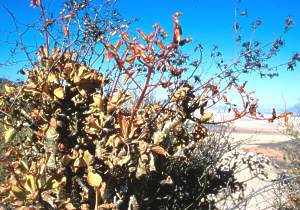Tylecodon paniculatus
Tylecodon paniculatus (L.f.) Tölken
Family: Crassulaceae
Common names: butter tree (Eng.); botterboom, baadtjies (Afrik.)
Introduction
Tylecodon paniculatus is a stocky, caudiciform, arborescent succulent that occurs over a wide area.

Description
Description
Tylecodon paniculatus can reach heights of 2 m, making it the largest of the tylecodons. It is summer deciduous. The plants conserve energy by photosynthesising through their greenish stems during the hot dry summer months. The yellowish-green, papery bark is a very attractive feature of this plant and has given rise to the common name. During the winter, plants are covered with long, obovate, succulent leaves clustered around the apex of the growing tip.

The long, reddish-orange, tubular flowers are borne in upright racemes at the onset of summer in November each year, just as the leaves turn yellow and drop off. In nature the plants tend to grow in groups, making a spectacular show when they flower. The seeds, which are very fine, are released from seed capsules during the autumn (March/April), just in time for the winter rains. In summer rainfall areas, flowering times and subsequent seed maturation may be delayed by a few months. The shrub is reported to have a surprisingly weak and shallow root system for its size.

Distribution and habitat
Distribution description
Tylecodon paniculatus is found from Eastern Cape near Steytlerville in the Little Karoo, along the southern and western Cape coastline, and as far north as the Auas Mountains in central Namibia. It is common in the Worcester/Robertson Karoo, the Bushmanland area, and northern Namaqualand.
Tylecodon paniculatus appears to have wide tolerance of growing habitats, growing in weathered rock in the north to coastal sands in the south.
Derivation of name and historical aspects
History
The genusTylecodon is an anagram of the original genus Cotyledon. It was the taxonomist Tölken who described this new genus in Bothalia 12 (1978).
The genus Tylecodon, of which there are 45 species, is divided into two groups: dwarf to small shrubby species, and the medium to large species. The variousTylecodon species are endemic mainly to the dry western areas of South Africa and Namibia.
Ecology
Ecology
The attractive, bright flowers are bird-pollinated. The flowers contain nectar protected by a tuft of hairs halfway up the inside of the corolla tube. These hairs are easily pushed aside by the bird's beak, and lesser double-collared sunbirds have been observed visiting the flowers.
Hybrids of T. paniculatus and related species have been reported.
Uses
Use
The botterboom is poisonous to stock, causing 'krimpsiekte'. In the past, the smooth, slippery stems were sometimes used to slide or ski at great speed down smooth rock faces or dam walls, adrenaline rushes before the days of bungy jumping!
Growing Tylecodon paniculatus
Grow
Tylecodon paniculatus makes a wonderful pot plant. They are striking feature plants, ideal subjects for sunny, dry courtyardsand water wise gardens.
This species can be cultivated either by seed or by cuttings. Growing from seed (sexual propagation) is a long process and it will be many years before one has plants of any size.
The seed is very fine and light brown in colour. The seed takes about 4 months to mature. The easiest way of harvesting seed is to cut the branched fruiting bodies in late March (autumn in the southern hemisphere). Allow the seed capsules to open in a closed paper bag. This will ensure the seed is not lost through wind or other means.
Sow the seed in a seed box. DO NOT cover the seeds. Simply sow the seeds in a coarse sand topping, with a well-drained substrate underneath. Water with a fine mister or a fogger once a week during winter and once a month in summer. The seeds will germinate readily during the cooler period of the year. After about two years, the young plants will be about 2-3 cm in height and can be pricked out and planted in bags. Always ensure that plants are grown in a well-drained medium.
To grow from cuttings (asexual propagation), select cutting material at least 3 cm in diameter. Place cuttings in a sharp quartzite substrate and use bottom heat if the winters are very cold. The cuttings usually take about one year to form a strong root system. Plant these cuttings in well-drained soil. Give them a sunny position.
References
- COURT, D. 2000. Succulent flora of southern Africa, revised edn. Balkema, Rotterdam.
- BARKHUIZEN, B. P. 1978. Vetplante van Suidelike Afrika. Perskor, Johannesburg
- HENDERSON, M. 1953. Cotyledon paniculata. The Flowering Plants of Africa 29: t. 1142.
- BURGER, S. 2002. Poisonous plants 2: Botterboom. Farmers Weekly,1 March: 28.
- GESS, S. et al. 1998. Birds, wasps and tylecodons: pollination strategies of two members of the genus Tylecodon in Namaqualand. Veld & Flora 84: 56, 57.
Credits
Ian Oliver and Yvonne Reynolds
Karoo Desert National Botanical Gardens
August, 2002
Plant Attributes:
Plant Type: Shrub, Succulent
SA Distribution: Eastern Cape, Northern Cape, Western Cape
Soil type: Sandy, Loam
Flowering season: Early Summer
PH: Neutral
Flower colour: Red
Aspect: Full Sun
Gardening skill: Easy
Special Features:
Horticultural zones








Rate this article
Article well written and informative
Rate this plant
Is this an interesting plant?
Login to add your Comment
Back to topNot registered yet? Click here to register.